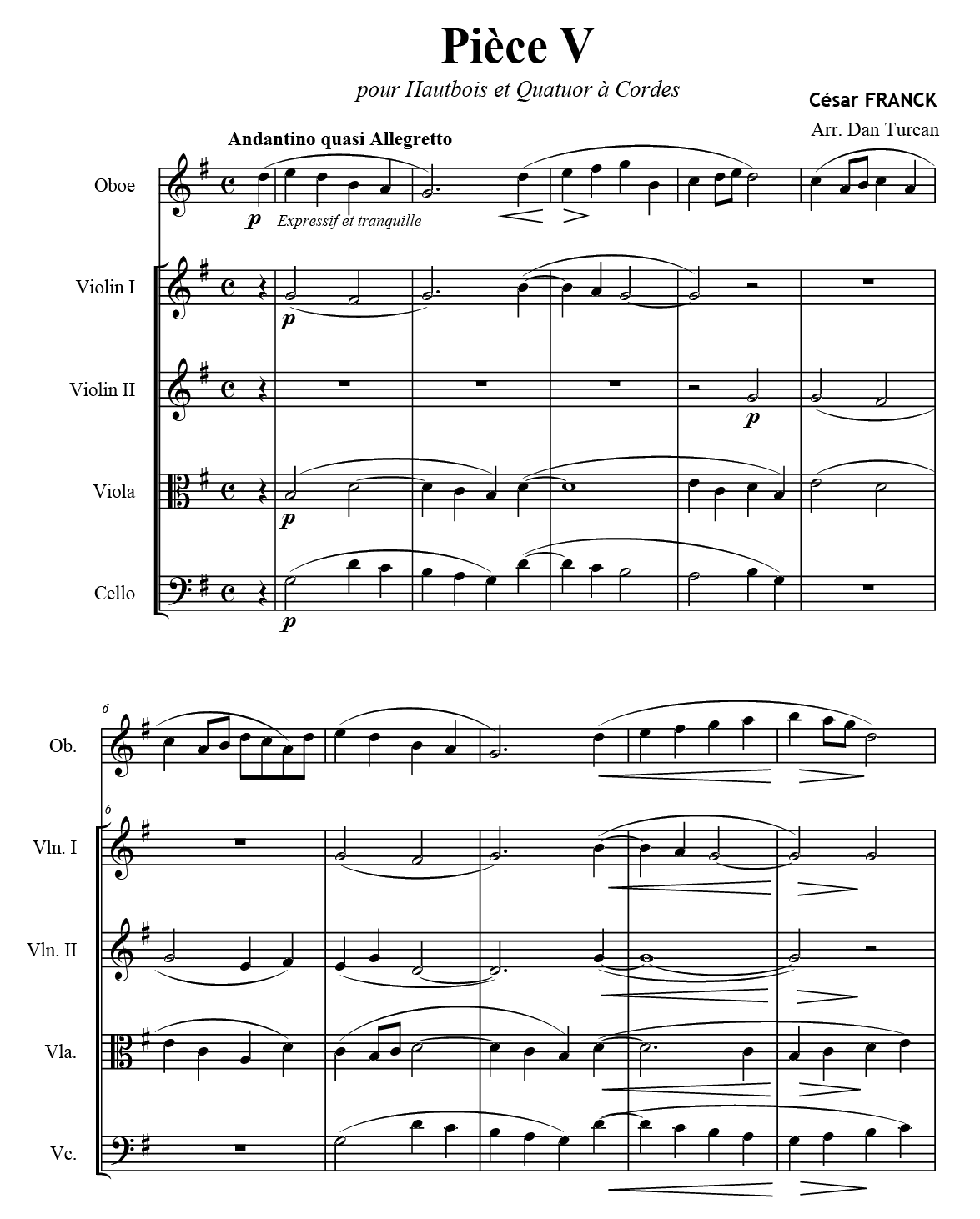

César Franck
(geb. Lüttich [Liège], 10. Dezember 1822 — gest. Paris, 8. November 1890)
«Communion»
Pièce V, 1864
für Oboe oder Blockflöte oder beliebiges Soloinstrument und Streicher
arrangiert von Dan Turcan (2013)
Vorwort
So bekannt und häufig aufgeführt einige der großen Werke César Francks sind (z. B. die Sonate für Violine und Klavier, die Symphonie, die «Variations symphoniques» für Klavier und Orchester oder das Klavierquintett in f-moll), so wenig ist stets die Rede von seinen kleineren Kompositionen, die gerne als reine „Gebrauchsmusik“ angesehen werden (als gäbe es „brauchbare“ Musik, die nicht „zum Gebrauch“ vorgesehen ist). So wissen auch die wenigsten, dass er neben den wenigen größeren Klavier- und Orgelwerken und den kleinen Orgelkompositionen auch eine Vielzahl Miniaturen für Harmonium geschrieben hat.
Unter diesen in ihrer Schlichtheit teils sehr inspirierten und bezaubernden Stücken finden sich auch die relativ bekannten «Cinq Pièces pour harmonium», die 1864 veröffentlicht und später als Nummer 26 in das Franck-Werkeverzeichnis aufgenommen wurden. Das finale Stück daraus, «Communion», erschien 1922 als «Pièce V» ohne weiteren Verweis auf seine Herkunft bei Leduc in Paris in einer Fassung für Oboe und Klavier. Auch ist nicht zu ersehen, ob diese seither viel gespielte Bearbeitung wirklich von Franck selbst stammt – was jedoch für Ausführende und Hörer keine gravierende Rolle spielt, da die Bearbeitung stilistisch sauber und effizient gesetzt ist und sich ohnehin für jede Art Melodieinstrument mit Begleitung jeder Art Tasteninstrument eignet. So haben wir auch Beispiele gefunden, wo «Pièce V» auf Kontrabass und Orgel, auf Bassblockflöte und Cembalo, oder auf Posaune und Klavier vorgetragen wurde. Jedenfalls können sich beispielsweise alle Blockflötisten, Fagottisten, Bratschisten usw., und natürlich die Oboisten ermuntert fühlen, dieses feine kleine, technisch anspruchslose Juwel zu passendem Anlass in ihrem Repertoire zu führen. Und gerade auch für Anfänger etwa auf der Violine oder dem Cello ist «Pièce V» sehr zu empfehlen.
An alle diese Instrumentalisten richtet sich auch die hier erstmals vorliegende Bearbeitung für beliebiges Soloinstrument und Streicher (die Begleitung kann selbstverständlich wahlweise solistisch oder chorisch sein), die Dan Turcan 2013 nach der Fassung für Oboe und Klavier vorgenommen hat. Da es sich tatsächlich um eine sehr noble, feinsinnig harmonisierte Melodie handelt, ist das Stück für ein symphonisches Konzert mit hochrangigen professionellen Kräften, in welchem für einen Moment „die Zeit stehenbleiben“ soll, ebenso passend wie für Amateure und Kinder zuhause und in der Schule. Wie schon die Übertragung für Oboe und Klavier ist auch hier erstmals vorliegende Orchestration derselben vom originalen E-Dur des Harmoniumstücks «Communion» nach G-Dur transponiert.
Christoph Schlüren, April 2013
Einzelstimmen sind vom Verlag Musikproduktion Höflich, München, zu beziehen (www.musikmph.de).
César Franck
(b. Liège, 10 December 1822 — d. Paris, 8 November 1890)
«Communion»
Pièce V, 1864
Arranged for oboe, recorder or any solo instrument and strings
by Dan Turcan (2013)
Preface
If some of César Franck’s large-scale works (the Violin Sonata, the D-minor Symphony, the Variations symphoniques for piano and orchestra, the Piano Quintet) are well-known and often performed, the same cannot be said of his lesser pieces, which are fondly dismissed as pure Gebrauchsmusik (as if any “usable” music were not intended “for use”). Similarly, few people know that, besides his small number of larger piano and organ works and his short pieces for organ, he also wrote a great many miniatures for harmonium.
One of these latter pieces, some of which are inspired and enchanting for all their simplicity, is the relatively familiar Cinq Pièces pour harmonium, published in 1864 and later included as no. 26 in the Franck thematic catalogue. The last of these five pieces, “Communion,” was published by Leduc of Paris in 1922 in a version for oboe and piano, entitled Pièce V but with no further indication of its provenance. Nor does the print say whether this frequently heard arrangement actually stems from Franck himself. That said, the point is of no great import to performers or listeners, for the arrangement is stylistically accurate, efficiently executed, and suitable for any sort of melody instrument accompanied by any sort of keyboard instrument. We have found cases where Pièce V has been played by double bass and organ, bass recorder and harpsichord, and trombone and piano. In any event, all players of the recorder, bassoon, viola, and so forth, not to mention the oboe, should feel encouraged to add this small, polished, technically undemanding gem to their repertoire for fitting occasions. It can also be highly recommended for beginners on, say, the violin or cello.
The present arrangement for solo instrument and strings (whether one or more to a part) is aimed at all these instrumentalists. It was prepared by Dan Turcan in 2013 from the version for oboe and piano and appears here for the first time in print. Since the melody is indeed very noble and deftly harmonized, the piece is no less suitable for high-caliber professionals who wish to make “time momentarily stand still” in an orchestral concert, than for amateurs and children playing at home or in school. As in the transcription for oboe and piano, our orchestration of Communion, published here for the first time, transposes the original E major of the harmonium piece to G major.
Translation: J. Bradford Robinson
For parts contact the publisher Musikproduktion Höflich, Munich (www.musikmph.de).